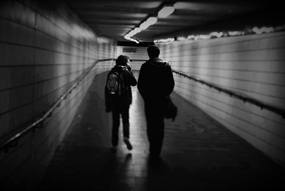I’d been to Barrow once before, in the long summer of 1995. I’d shared a Liverpool student flat with a friend who’d grown up in the town, and one weekend we took the train to stay with his family. I remember the beauty of the journey from Lancaster to Barrow, taking in Morecambe Bay and the mountains. I remember the dusty walk across the hot August town from the train station. I remember the warmth of his family’s welcome, and the red welt on my arm after a Cumbrian horse-fly, a clegg, took a bite. But we had really travelled through Barrow, because my friend had actually grown up in a tiny hamlet outside the town, a place called Paradise.
Coming back, nearly 20 years later on a grey Spring morning for a walk around the town with Jenn and Beth, made me recognise the similarities with my own upbringing in Thames-side Essex. The salt marshes and tidal muds of Walney reminded me of Benfleet, Canvey Island and Pitsea; pillboxes marshalled the landscape; the black water of deep-water channels and the call of gulls were strangely familiar. Towns at the end of the railway, a terminus, places where no-one passes through on the way to somewhere else, because after here, there’s nowhere else to go – unless, of course, you are on the way to Paradise.
Through writing a critical book on Iain Sinclair, and beginning a project with an old friend from home, I’d been trying to come to terms with growing up in South Essex, a place I couldn’t wait to leave. The journey to Barrow, to the streets of a planned town, to big skies and grey-green water, to the smell of silt and salt, was in some ways a return. To think myself, or rather to feel myself into that place, a town I didn’t really know, was a chances to draw lines back to my own teenage years and a place I now visited infrequently, to see my own family.
Doors opened. And not just to my own past or relationship to Essex and to Barrow, but in this shared writing and imagining of the story of The Barrow Rapture. Ideas, images, locations emerged as we wrote, and Beth drew and painted. Sometimes I was surprised by what appeared on the page as I wrote myself.
Stories, I suppose, are both personal and shared, coming to life as the circuit between the text and the reader. The form of The Barrow Rapture emphasises that process of transmission and creation. In collaborating with Jenn, Tom and Beth, I’ve discovered how a project like The Barrow Rapture is both personal and shared, and in its transmissions gains a kind of unexpected life and shape, and I hope it continues to do so.
Brian Baker
http://sciencefiction365.blogspot.co.uk
Coming back, nearly 20 years later on a grey Spring morning for a walk around the town with Jenn and Beth, made me recognise the similarities with my own upbringing in Thames-side Essex. The salt marshes and tidal muds of Walney reminded me of Benfleet, Canvey Island and Pitsea; pillboxes marshalled the landscape; the black water of deep-water channels and the call of gulls were strangely familiar. Towns at the end of the railway, a terminus, places where no-one passes through on the way to somewhere else, because after here, there’s nowhere else to go – unless, of course, you are on the way to Paradise.
Through writing a critical book on Iain Sinclair, and beginning a project with an old friend from home, I’d been trying to come to terms with growing up in South Essex, a place I couldn’t wait to leave. The journey to Barrow, to the streets of a planned town, to big skies and grey-green water, to the smell of silt and salt, was in some ways a return. To think myself, or rather to feel myself into that place, a town I didn’t really know, was a chances to draw lines back to my own teenage years and a place I now visited infrequently, to see my own family.
Doors opened. And not just to my own past or relationship to Essex and to Barrow, but in this shared writing and imagining of the story of The Barrow Rapture. Ideas, images, locations emerged as we wrote, and Beth drew and painted. Sometimes I was surprised by what appeared on the page as I wrote myself.
Stories, I suppose, are both personal and shared, coming to life as the circuit between the text and the reader. The form of The Barrow Rapture emphasises that process of transmission and creation. In collaborating with Jenn, Tom and Beth, I’ve discovered how a project like The Barrow Rapture is both personal and shared, and in its transmissions gains a kind of unexpected life and shape, and I hope it continues to do so.
Brian Baker
http://sciencefiction365.blogspot.co.uk










 RSS Feed
RSS Feed
